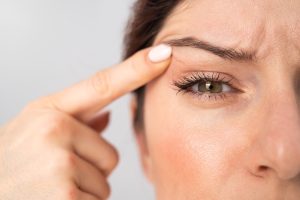Understanding Eye Twitching
Eye twitching, medically referred to as myokymia, is a common occurrence that many individuals experience at some point in their lives. This involuntary spasm of the eyelid muscles can vary in duration and frequency, often presenting as a minor annoyance but occasionally escalating to a more persistent issue. Despite its prevalence, the underlying causes of eye twitching remain a subject of curiosity and concern for many. Explore More About (Knees Arthritis Shots)
The Physiology of Eye Twitching
At its core, eye twitching involves the involuntary contraction of the orbicularis oculi muscle, responsible for controlling eyelid movement. These spasms typically occur in one eyelid, although they can affect both simultaneously or alternate between the two. While the exact triggers for these contractions may vary, they are often benign and temporary, resolving without intervention.

Common Triggers for Eye Twitching
Understanding the potential triggers for eye twitching is essential in managing and alleviating this phenomenon. While stress and fatigue are frequently cited as leading culprits, several other factors may contribute to the occurrence of eye twitching:
1. Fatigue and Sleep Deprivation
Inadequate rest and sleep deprivation can strain the body, leading to muscle fatigue and increased susceptibility to eye twitching. Prioritizing sufficient sleep and incorporating relaxation techniques into daily routines can help mitigate this trigger.
2. Stress and Anxiety
Heightened stress levels can manifest physically, often manifesting as muscle tension and involuntary movements such as eye twitching. Implementing stress-reduction techniques, such as mindfulness meditation or deep breathing exercises, can aid in managing stress-related eye twitching.
3. Caffeine and Stimulant Consumption
Excessive consumption of caffeine and other stimulants can overexcite the nervous system, potentially triggering eye twitching episodes. Moderating caffeine intake and staying hydrated can help regulate nerve function and reduce the likelihood of spasms.
4. Eye Strain and Digital Eye Fatigue
Prolonged periods of screen time and intense visual focus can strain the eyes, leading to discomfort and twitching. Employing the 20-20-20 rule—taking a 20-second break every 20 minutes to focus on an object 20 feet away—can alleviate strain and reduce the risk of twitching.

5. Nutritional Deficiencies
Inadequate intake of certain vitamins and minerals, such as magnesium and potassium, may contribute to muscle irritability and twitching. Ensuring a balanced diet rich in essential nutrients can support overall muscle health and minimize the occurrence of twitching.
When to Seek Medical Attention
While most cases of twitching are harmless and self-limiting, there are instances where medical evaluation may be warranted. Individuals experiencing any of the following symptoms alongside twitching should consult with a healthcare professional:
- Persistent twitching lasting more than a few days
- Twitching affecting other facial muscles
- Eyelid drooping or difficulty keeping the eye open
- Redness, swelling, or discharge from the eye
- Vision changes or disturbances

Treatment and Management Strategies
For occasional and mild cases of twitching, simple lifestyle modifications and self-care practices may suffice. However, persistent or bothersome twitching may require additional interventions, including:
- Stress Management: Incorporating stress-reduction techniques such as yoga, meditation, or progressive muscle relaxation can help alleviate twitching associated with heightened stress levels.
- Eye Hygiene: Practicing good eye hygiene, including regular breaks from screen time, proper lighting, and adequate hydration, can reduce strain and minimize twitching episodes.
- Nutritional Support: Ensuring adequate intake of essential nutrients, particularly magnesium and potassium, through a balanced diet or supplements can support muscle health and reduce the frequency of twitching.
- Medical Interventions: In severe or persistent cases of twitching, healthcare providers may recommend medical treatments such as botulinum toxin injections or prescription medications to alleviate symptoms and manage underlying causes.
Lifestyle Practices for Managing Eye Twitching
| Management Strategy | Description |
|---|---|
| Stress Management | Techniques such as yoga, meditation, or deep breathing to reduce stress levels and muscle tension. |
| Eye Hygiene | Practices including regular breaks from screen time, proper lighting, and hydration for ocular health. |
| Nutritional Support | Ensuring adequate intake of essential nutrients like magnesium and potassium for optimal muscle function. |
| Medical Interventions | Treatment options such as botulinum toxin injections or prescription medications for severe cases. |
Conclusion
In summary, eye twitching is a common phenomenon characterized by involuntary spasms of the eyelid muscles. While typically benign and self-limiting, twitching can be disruptive and concerning for affected individuals. By understanding the potential triggers, implementing preventive measures, and seeking appropriate medical guidance when necessary, individuals can effectively manage and alleviate eye, restoring comfort and optimizing ocular health.




